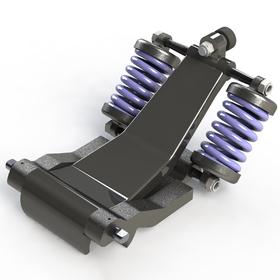
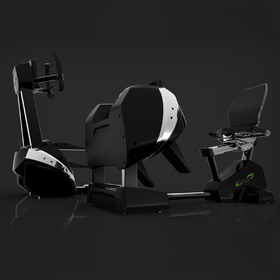
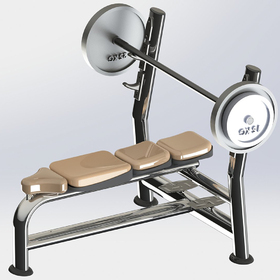
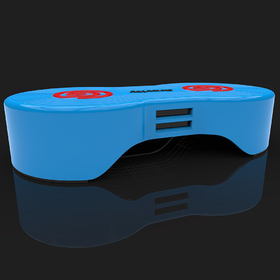
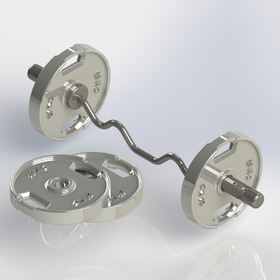
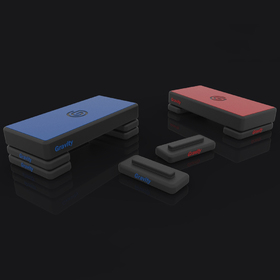
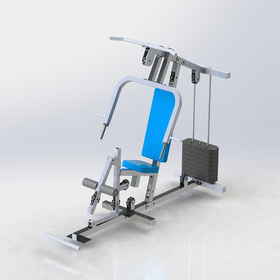







The fitness industry in America is both vast and complex, with a wide and varied consumer base. Gyms are no longer seen as the exclusive territory of bodybuilders and professional athletes. More and more people are drawn to fitness each year and this ongoing trend has created an expanding market for all types of exercise equipment. From wearables like GarminTM watches and heart rate monitors to spin bikes and CrossFit setups, innovative exercise-related products are very much in demand.
So, how can you take your next big idea from a brainstorming session to a manufactured product that may revolutionize the fitness industry? Cad Crowd’s freelance product designers can guide you through the design process. We provide a full suite of product design services, from analysis of the initial concept to CAD designs and production-grade prototypes. Cad Crowd has reinvented product design and brought it into the 21st century.
Since we work through freelance designers rather than salaried employees, overhead costs are lower, and our product design services are extremely flexible. Cad Crowd offers quotes for pre-defined projects as well as hourly services that are more open-ended in scope. These can be tailored to individual entrepreneurs or businesses of any size. It is also important to note that Cad Crowd keeps projects confidential and that designers go through a vetting process before they start their work.
Product design with Cad Crowd follows three steps: analysis, conception, and implementation (see more on this here). During the analysis phase, your team will work with you to designate the problem you’re looking to solve with your product and brainstorm ways to approach that issue.
When designing exercise equipment, it is crucial to designate a target market early in the process. Are you trying to sell commercial equipment to larger gyms and training facilities (weight racks and machines), or create a product that people can use in the comfort of their homes (pull-up bars and dumbbell racks)? It is also essential to define the innovative features that your product brings to the market. Why should a consumer choose your brand over all the others already available?
Below are some common categories of exercise equipment and suggestions for product design that should be considered during the analysis phase.
Weight machines
Almost every gym has a set of weight machines. They are popular because each machine trains a specific motion and activates a particular muscle group. Gym-goers will often create routines that sequentially use a set of machines to train complementary muscle groups. While this equipment is widely used, there is still significant room for improvement.
As new science comes out regarding effective ways to train muscles, new iterations of machines are built to recreate those motions as closely as possible. However, state-of-the-art machines may be prohibitively expensive for local gyms trying to compete with nationwide chains. Products that balance cost and quality training are always in demand.
Kettlebells and dumbbells
Kettlebells and dumbbells are two common versions of free weights used for strength training. They provide an advantage over machines because the path of the weight isn’t predetermined, forcing the body to use more muscles to stabilize the weight during the exercise. They usually come in a range of weights, from as low as one pound to as high as 100.
The basic design parameters of free weights are fairly simple. However, there is plenty of room for creativity. These innovative designs, from weights that are easily adjustable to ones that sync with your smartphone to accurately track calories throughout your workout, are just a few examples.
Home gym equipment
Devoting time and money to setting up a dedicated workout space at home is an attractive option for consumers who value fitness but may need a more convenient or less pricey alternative to a gym membership. Equipment meant to be used at home can range from simple to state-of-the-art depending on the buying power of your target market. Consumers will often search for designs that give them the most bang for their buck, especially with the limited space available compared to a full gym facility. Setups like a power tower allow users to perform a range of exercises including pull-ups, dips, chin-ups, and core exercises simply by changing their grip position or utilizing the different components of the apparatus.
Cardio equipment
Treadmills, elliptical machines, spin bikes, and rowing machines are staples at any gym. These machines focus more on training the cardiovascular system than on promoting muscle growth and add a valuable element to a strength-based training program. Cardio equipment design has several possible avenues for improvement, such as the way metrics are displayed, the ability to sync with a smartphone, Fitbit or GPS watch, and other user-friendly features.
Many users encounter boredom during longer training sessions, so designing equipment with screens, TV connectivity, or a place to connect headphones may increase consumer interest. Designers should also consider the placement of water bottle holders and effective yet streamlined safety features. Examples of ingenious product design include recumbent stationary bikes that accommodate people who cannot exercise in the regular position due to mobility issues or injury and treadmills that have segmented belts or curved belt tracks to better mimic outdoor running.
Recovery tools
Recovery gear is an often-overlooked aspect of exercise equipment, but it is an essential component of a good gym. Tools such as foam rollers help athletes warm up, massage out knots and soreness, and align muscle fibers before beginning their workout. They are also used after workouts for similar purposes and to flush the byproducts of hard work out of the system to allow the body to recover faster. The best recovery equipment is either designed to work on a specific area of the body at an acute level or has the functionality to target multiple areas. It should also be portable and easy to manipulate. Great examples include long-time favorite the Stick, the R8 from Roll Recovery, and this trigger point massage tool from REI.
In general, it is essential to consider the requirements of people who are most likely to use your product and design based on consumer need. This is especially relevant for exercise equipment design. Parameters such as the height and grip width of a pull-up bar, the circumference of a dumbbell grip, the range of seat heights on a spin bike, or length and weight gradations for barbells may be different for men, women, and teens. By considering user profiles, you may even find an opportunity to meet consumer demand by designing a product that offers a creative solution to a gap in the market.
The range and rigor of use is also an important factor that should be examined during the analysis phase. Is a rig going to need support for barbells at a variety of heights for various exercises such as squats from shoulder level and deadlifts from near the floor? What angles should a utility bench be able to move through? Weightlifters will often change the angle of a bench to support their bodies in different ways while targeting different muscles.
In recent years, group virtual fitness has become a quickly growing trend. Products such as the Peloton exercise bike and treadmill, or training programs and apps like Zwift are incredibly popular, as are virtual yoga routines and personal training sessions. To be competitive in a market that is increasingly tech-savvy, designers should carefully consider how to ensure compatibility with virtual training and electronic accessories.
The next step is to begin the actual design process. Cad Crowd’s experts can create concept models which help work out any early design issues before drawing up final plans. They can also create presentation models, which can be useful for pitching an idea to potential investors while still in the early stages of the design process. Eventually, your team of freelance product designers can draft detailed product designs using CAD software that is 3D-printing-ready.
This speeds up the production of prototypes for exercise equipment that will be subjected to consistent use and repeated stress. Creating production-grade prototypes before beginning to manufacture finished products is a crucial step, hence the importance of rapid prototyping.
Even the most well-designed and creative product won’t sell well without an effective marketing campaign. Advertising is the final and often overlooked step in product design. Your Cad Crowd freelance team can also provide input on successful marketing strategies, including creative packaging that will attract buyer attention and highlight the unique features of your product. They will also provide advice on the most effective ways to get the word out about your product in a very competitive and diverse market.
Cad Crowd’s network of designers, manufacturers, and design engineers can help you bring your idea for revolutionizing exercise equipment from an initial concept to an elegant mass-produced product. If you’re interested in working with Cad Crowd, talk to one of our design experts or get a quote from us today.
If you're looking for a product designer, a CAD designer, or even a 3D modeler for any purpose, let us at Cad Crowd help. We have the privilege of working with some of the best designers in the business. Whether you need exercise equipment designed or are looking for a prototype of your new car, let us help. Find out how it works.


